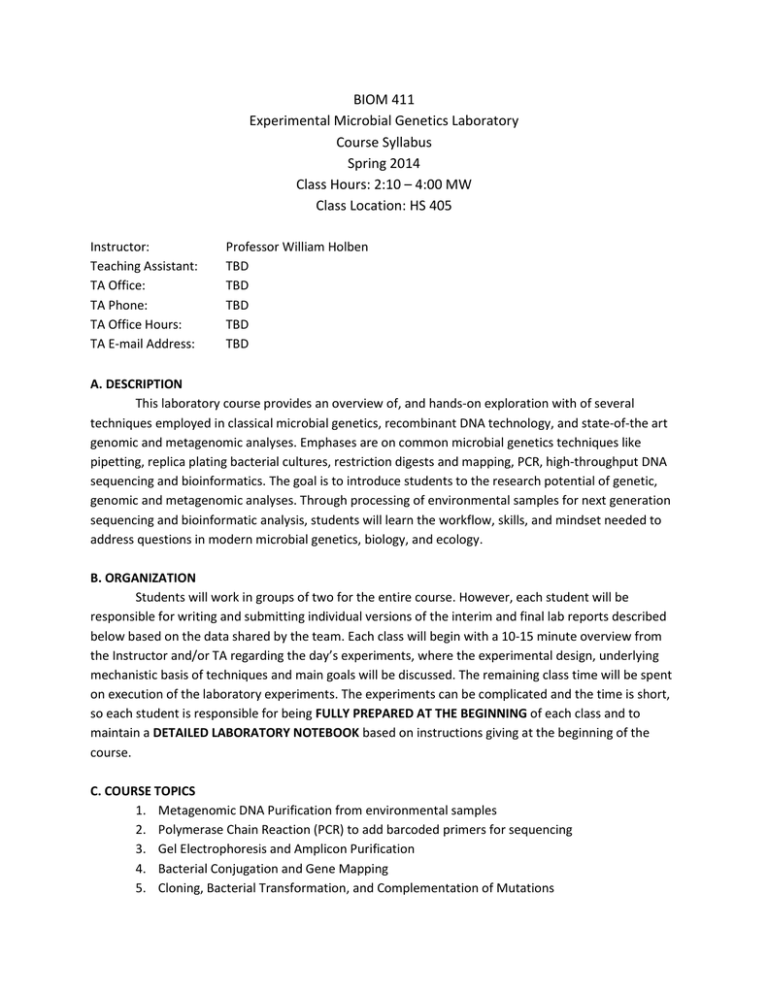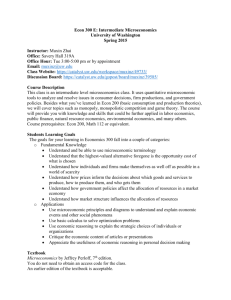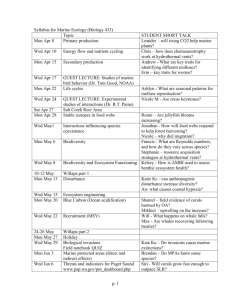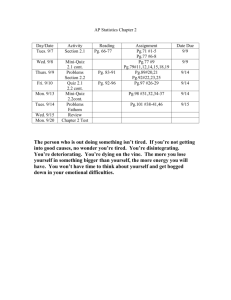BIOM 411 Experimental Microbial Genetics Laboratory Course Syllabus Spring 2014
advertisement

BIOM 411 Experimental Microbial Genetics Laboratory Course Syllabus Spring 2014 Class Hours: 2:10 – 4:00 MW Class Location: HS 405 Instructor: Teaching Assistant: TA Office: TA Phone: TA Office Hours: TA E-mail Address: Professor William Holben TBD TBD TBD TBD TBD A. DESCRIPTION This laboratory course provides an overview of, and hands-on exploration with of several techniques employed in classical microbial genetics, recombinant DNA technology, and state-of-the art genomic and metagenomic analyses. Emphases are on common microbial genetics techniques like pipetting, replica plating bacterial cultures, restriction digests and mapping, PCR, high-throughput DNA sequencing and bioinformatics. The goal is to introduce students to the research potential of genetic, genomic and metagenomic analyses. Through processing of environmental samples for next generation sequencing and bioinformatic analysis, students will learn the workflow, skills, and mindset needed to address questions in modern microbial genetics, biology, and ecology. B. ORGANIZATION Students will work in groups of two for the entire course. However, each student will be responsible for writing and submitting individual versions of the interim and final lab reports described below based on the data shared by the team. Each class will begin with a 10-15 minute overview from the Instructor and/or TA regarding the day’s experiments, where the experimental design, underlying mechanistic basis of techniques and main goals will be discussed. The remaining class time will be spent on execution of the laboratory experiments. The experiments can be complicated and the time is short, so each student is responsible for being FULLY PREPARED AT THE BEGINNING of each class and to maintain a DETAILED LABORATORY NOTEBOOK based on instructions giving at the beginning of the course. C. COURSE TOPICS 1. Metagenomic DNA Purification from environmental samples 2. Polymerase Chain Reaction (PCR) to add barcoded primers for sequencing 3. Gel Electrophoresis and Amplicon Purification 4. Bacterial Conjugation and Gene Mapping 5. Cloning, Bacterial Transformation, and Complementation of Mutations 6. Next Generation Sequencing (ultra-deep 16S gene sequencing using MiSeq) 7. Bioinformatic Analysis and Phylotype Classification D. REQUIRED SUPPLIES 1. Laboratory Notebook (must have a fixed binding, no loose-leaf binders allowed) 2. Ultra-Fine Sharpie 3. Lab Coat (if desired) E. GRADING AND COURSE REQUIREMENTS Each student will be required to maintain their own laboratory notebook and carefully record all details, calculations, observations, variations in protocol and all other details for each lab. Lab notebooks will be graded twice during the lab course. Two interim lab reports and a final lab report will be submitted during the semester to fulfill the requirements of the 2/3 writing component of this course. To enable these writing exercises, maintaining a well-organized laboratory notebook is not only required for its portion of the final grade and as good general laboratory practice, but will be essential for writing your lab reports. Note that scientific writing is an essential skill for any successful scientist. Thus the writing exercises for the course will cumulatively account for 60% of your final grade. Also note the key elements of successful modern scientific research include interaction, collaboration, and sharing of ideas. Thus, each student’s grade for this lab course will be broken down as follows: Lab Notebook 20% (10% at each inspection) Interim Lab Reports 30% (15% each for two submissions) Final Lab Report 30% Attendance/Participation 20% F. LABORATORY REPORT FORMAT The purpose of the laboratory report is to communicate your scientific research (experimental work) in writing. This is a necessary skill, regardless of the field of science you are in. The goal is to help each student practice expressing their ideas and communicating their results in a scientifically professional manner. Thus, the format of the laboratory reports will be similar to that in peer-reviewed scientific literature or in applications for federal research funding. Briefly: 1. The interim and final lab reports must be submitted to the TA via e-mail as a .doc file via email by midnight on the due date. 2. The lab reports will have a title page that includes the course number and name, the student’s name, ID number, date, and a descriptive title for their work. 3. Acceptable lab reports will be single-spaced in an easily readable 12-point font with each page numbered at the bottom. The two interim lab reports should be in the range of 3–4 pages, while the final report should be 5-7 pages. 4. Reports must be in grammatically correct English without spelling errors (use your spellchecker!) as such errors will count against your rate. Please note that you will receive both the grade and constructive feedback on each of the interim lab reports that will provide valuable information and guidance for you in preparation for your final lab report. 5. Figures will be labeled as “Figure 1”, etc. and Tables as “Table 1”, etc. and should be embedded in the text if possible. Each figure will have a legend that describes the figure in sufficient detail. All tables will have a title at the top of the table. Font size for legends and descriptions can be smaller but a minimum of 10-point font. 6. References cited will be indicated by sequential numbers e.g. (1), (2,3) in the body of the report, with a bibliography of references cited at the end of the report using ASM format (this will be provided on the Moodle site). Students are to rely primarily on peer-reviewed publications and not on Internet sites, blurbs, Wikipedia, etc. such that there are at least 2-3 citations from the primary literature for each one from the Internet. 7. The sections of the reports will be as follows: A. Introduction – Background information on the theory behind the experiment, system of study, questions/hypotheses that will be investigated, and general approach to answering them. B. Materials and Methods – Step by step (in prose) description of the experimental methods. We will discuss in class where it is appropriate to simply cite materials from handouts versus writing up your own materials and methods and protocols. C. Results – State the results of the experiments with descriptive figures and tables and accompanying explanation. Do not analyze the results in terms of how they relate to the questions being asked in the study, just state the results. D. Discussion – Discuss the results with regard to how well they address the hypotheses or research questions that you were addressing. Draw conclusions, state strengths and limitations the techniques employed and how these qualify or strengthen your conclusions. Discuss how you would overcome such limitations in future experiments as well as the next logical steps to further your investigation. G. ACADEMIC HONESTY Appropriate ethical behavior in the classroom is required of every University of Montana student. Academic misconduct is subject to an academic penalty by the course instructor and/or a disciplinary sanction by the University. All written assignments in this class must be completely original. Definition: Academic Dishonesty “cheating” and “plagiarism”, the theft of ideas and other forms of intellectual property – published or unpublished. Definition: Plagiarism is the use of another writer’s words or ideas without acknowledging the source. Plagiarism also means “passing off a source’s information, ideas, or words as your own by omitting to cite them, which makes it an act of lying, cheating, and stealing.” Definition: Cheating is defined as obtaining or attempting to obtain, or aiding another to obtain credit for work, or any improvement in evaluation of performance, by any dishonest/deceptive means. All students need to be familiar with the Student Conduct Code, which is available for review at life.umt.edu/vpsa/student_conduct.php Accommodations We are happy to work with students and Disability Services for Students (DSS) to make accommodations that facilitate all students’ class participation and learning. Please see me on the first day of this class to plan for any such accommodations. H. TENTATIVE SCHEDULE DATE Mar 11 Mar 16 DAY WED MON Mar 18 WED Mar 23 Mar 25 MON WED Mar 30 Apr 1 Apr 6 Apr 8 Apr 13 Apr 15 MON WED MON WED MON WED Apr 20 Apr 22 Apr 27 Apr 29 May 4 May 6 MON WED MON WED MON WED TOPIC Introduction to the course: goals and overview of experiments Extraction of DNA from environmental samples; PCR to test 16S amplification ability/efficiency Gel electrophoresis of PCR amplicons and subsequent barcoded PCR to generate 16S amplicons for sequencing Gel electrophoresis for 16S amplicon purification Extract and purify DNA from gel, AMPure XP DNA Purification; submit notebooks for 1st grading; Interim Lab Report 1 due Spring Break, no class Spring Break, no class Bacterial Conjugation and Gene Mapping Part 1: Bacterial Conjugation and Gene Mapping Part 2; Cloning and bacterial transformation Scoring complementation, plasmid purification; Interim Lab Report 2 due Restriction digestion of clones, gel electrophoresis Restriction mapping of clones Bioinformatics overview; download sequence data, prepare mapping files QIIME analysis of sequence data; Bioinformatic analysis continued as needed Teaching evaluations, data review; capstone discussion; Final Lab Report and notebooks due Wednesday, May 13







